Body as Itself
patrick brennan
April 2015
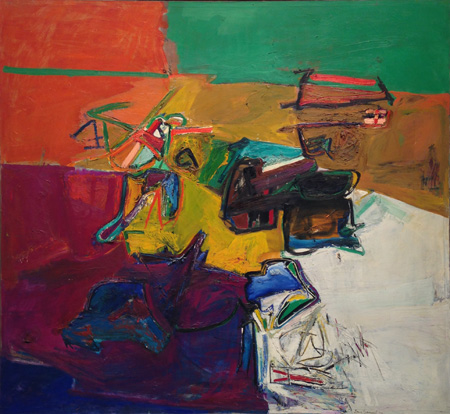 Perfil infinito, 1966
Perfil infinito, 1966
Joan Semmel: Across Five Decades
Alexander Gray Associates 510 West 26 Street
April 2 – May 16
Joan Semmel’s one helluva painter, and has clearly been so for a very long time now. I’ve come across her work peripherally here and there without that much connection. However, this last Saturday I was arrested via the corner of my eye through ground floor windows on West 26th street by no more than an unfocused gestalt of a very distinctive rhythm and placement of color, which turned out to be an early abstract work from 1966, Perfil Infinito. That was enough to tell me that there was something more to see. Stopping to peer in more closely, I noticed to the left an intimate portrayal of cunnilingus, which I can’t deny almost irresistibly piqued my curiosity in still another way; and while I was yet to catch up to the context and story of these images, their aura of well earned authority informed me instantly that what I was witnessing was not superficial.
This is a gallery retrospective of 5 decades of work from the early ‘60s to the present. The early abstract work is already marked by clear identity and self awareness. It doesn’t come across as everyday second or third generation abstract expressionist. While sharing and living that language, it also holds its own very well, thank you.
She lived with her family while painting in Madrid for a number of years during that decade under Franco, where the fascist regime’s female directed apartheid, which systematically repressed even the minutia of day to day exercises of women’s social autonomy sharpened her alertness to the pernicious impact of assumed and applied male domination on a society and its individuals.
Returning to New York by the early ‘70s, this heightened sensitivity allied with the developing feminist upsurge in the United States, which further expanded the range of questions she was addressing as a visual artist. Aware of the overload of conventional representations imposed upon women both through contemporary commercialized culture and centuries of Pan-European art, she considered how she could engage an articulation of the feminine in the first person, an investigation of the appearance of women from within the experience of a woman.
Her solution was brilliant, almost blindingly obvious, simple and deeply responsible. She would present the experience of female physicality from the perspective of of her own eyes, from which her own body would become the landscape of the world. This is something anyone could do, male or female, but it had powerful political implications in light of the marginalization of women’s perspectives in any society, and of course, no less so in its art.
Politics is effectively an effort to influence other people’s behavior. Semmel’s work can change the way a person conceives and experiences existence, and such a shift can reshape how one acts. However, there’s no shortage of politically directed artistic action oriented specifically toward affecting the concepts and corresponding behavior of other people, and, because it’s often willing to settle just for that, it can end up not really so distinct from advertising or propaganda and can be just about as easily forgotten. What Semmel has chosen to do is more courageous and complicated in that it’s not didactic. It’s no illustrated lecture. No protesting. No denouncing of wrongs. Her art seems to already assume the success of her understandings and worldview and explores the immediate implications of living it. This may be a woman painting. This could be called “feminist” painting too, and that wouldn’t necessarily be incorrect either. It also doesn’t matter. There are no apologies or excuses here. These pieces are too complex and rich for expiration as one shot deals. Their staying power continually invites, intrigues and engages.
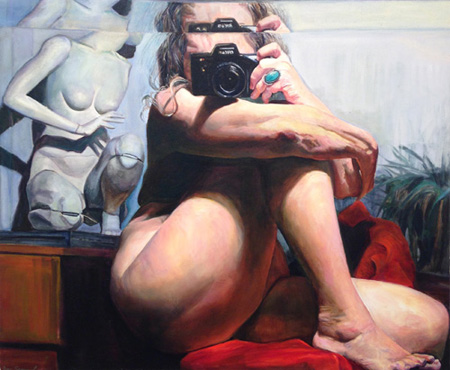 Centered, 2002
Centered, 2002
A 2002 work, Centered, shows a nude Semmel seated next to a sculpted female figure (is this statue – or is it a fashion manikin — proposing an “ideal” standard?) facing her own mirrored reflection while gazing directly through a camera also at the viewer. There is a slight doubling of the image, (which might derive from there being two overlapping mirrors) where a staggered repetition of the upper portion can be seen just above the intact depiction. I think about photocopying and about collage, but this is manually conceived & thought through. However referenced, it’s all painted.
I also think about that death wish for painting issued by Douglas Crimp (who called it “pure idiocy”) and so many others during the same decades Semmel’s been developing her work, and I see how she’s saying and seeing things that photography (not to mention newer visual technologies), for all its strengths & opportunities, doesn’t touch what’s seen with the same grain of detail, attention and responsiveness. For all their overlaps, they really aren’t the same processes, nor are they mutually interchangeable. Both may yield images, but they’re not the same acts (as is likewise true with music, where performance evolution is not equivalent with its recorded artifact. None of this is so simple as the linear teleology of production.). To each its own.
What I also sense throughout is a tremendous degree of curiosity in Semmel’s work, the camera in Centered is just one of many agents and vehicles as is her self directed investigatory gaze. It’s also especially hard to ignore her treatment of paint, her astute awareness of light, her extraordinary love and understanding of color. Like Cezanne, each mark resonates as a specific event, each a distinct and unique consideration. The work is neither rote nor technocratically dispatched. She really paints. Compare what she does with photorealism. Although she works with and from the photograph, and although her figures do tend to correspond pretty well with the conditions of linear perspective and such, she reserves the option at any moment to differ, to diverge, to restate, to reconsider and reevaluate. That living and mutable intelligence is available through any detail of any one of her paintings.
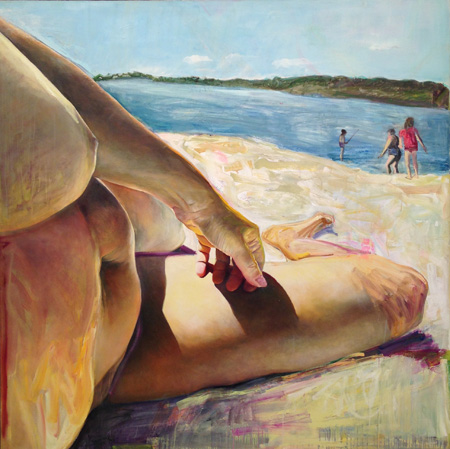 Beachbody, 1985
Beachbody, 1985
In the 1985 Beachbody, Semmel paints from a photograph she took of herself reclining in the sand, where in the distance well beyond her toes one can recognize shoreline, a few figures at the edge, water, a barrier island beyond and sky. The foreshortened perspective is radical. Her breast looms close, nearly on right on top of the observing eye. The belly recedes from nearly the full height of the canvas. The right thigh and calf occupy as much literal canvas space as do sky, bay & island combined. The body, the painter’s own, becomes a field of shapes, a landscape full of fascinating visual problems.
Here also examples yet another intractable divergence of painting from photography. To be actually seen and felt, these paintings really have to be apprehended first hand. In reproductions, where the paint’s textural insistence becomes muted, if not gagged, these works might begin to seem far tamer constructions, as if only illustrations. In addition to this, her sense of the relation of a painting’s size to the human scale of the viewer is very, very exacting. In Beachbody, from a distance of 3 feet, the breast shape palpably impinges upon the viewer, almost forcing itself out of focus as it engulfs the left horizon of vision, exerting a powerfully visceral, difficult to describe presence and pressure. This sensation contrasts sharply with the visual field to the right, the contrast itself being part of the statement.
As portraiture, there’s also that out and out weirdness of witnessing one’s own body as an object, or entity, separate from one’s awareness of it, as something other, autonomous, while the very same moment that observed field is delivering sensuous, proprioceptive, tactile information from within. This “other,” this paradoxical other, is also oneself, and this is, after all, exactly where we live.
I’m looking right now at the gallery’s accompanying press release, where it reports that “she aimed to capture a psychological experience, particularly the feeling of aloneness that can persist even while on a crowded beach.” The use of “persist” seems to imply that this is a lamentable condition, but being alone and aware can be a rich and delicious experience too and may even be an important component of seeing with the sensitivity to complexity that she displays in every work here. The serenity and quiet of a beach, the breathing of one’s skin, the touch of breeze and the relaxing penetration of solar warmth, the way the mind can float & restore in such a bubble of solitude outside the to-do list elsewheres of linear time aren’t necessarily such bad things either. Maybe it’s a relief that all those people are off in the distance for the moment.
All these musings aside, what kept me looking and looking were the enfoldings of syncopated contradictions, the push-pull of the actual two dimensional shapes of foreshortened design in contradiction with my more tactile three dimensional projection of the figure in extension (still more weirdness of being — the actual size and proportion of the right calf and foot never stops feeling uncanny) as well as the push-pull between the isness of abstract painting and the referential indications of depiction. It’s hard to ruminate long on the body or beach without digressing into the shapes all on their own or the continually fascinating bursts of strokes, especially where she delineates light as the right thigh meets the silica ground.
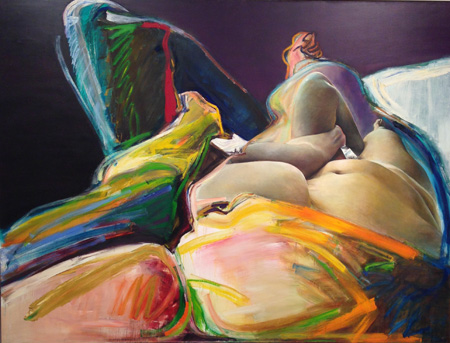 Purple Diagonal, 1980
Purple Diagonal, 1980
Strokes especially dominated my initial impressions of Purple Diagonal from 1980. From reasonably up close, I experienced the variegated color strokes as purely abstract with some confoundingly literal rendering of a foreshortened torso positioned in the middle. At first I thought I was meeting a somewhat different sort of formal cognitive dissonance than what Picasso had stumbled into during his 1907 Le Bordel d’Avignon, but I eventually reconstructed what I was seeing and recognized that Semmel had instead integrated two differently articulated depictions of her own body receding away from her head, the larger an explosion of multicolored strokes containing a smaller, more detailed accounting of light as reflected off flesh. Rather than posing a conflict of styles, these differences seem to explore two simultaneous alternative modes of experience or awareness. Compositionally, it’s fascinating and arrestingly original work.
Where else — after eliminating pain, discomfort, fatigue and hunger from consideration, as all of these tend to contact, rather than expand, awareness — could the paradoxical existential experience of one’s own body as landscape arrive with any more vividness than in sex? This is embodied experience par excellence, of such import that people are often willing completely reorganize their lives on its behalf. Sometimes Semmel depicts sex directly from the perspective of the person actually involved, and even in other paintings, the viewer doesn’t see faces. What one sees are the media, the skin and sexual organs, where sensation is most intense, and this is most of what there is to see during sex. The skin itself as a visually expressive medium, seems fairly impassive in contradistinction to what touch so penetratingly delivers.
Semmel’s treatment of figures in the sex paintings reminds me even more of the figures in Jorge González Camarena’s 1963 mural Liberación de la humanidad in Mexico City’s Palacio de Bellas Artes than conceivably even of Matisse (in that none of the three are using naturalistic color for the body). González Camarena accomplishes a nearly magical ambience through almost transparently electric hues. Semmel adopts similar strategies with even more powerfully affective resonance. In Erotic Yellow (1973), a pink woman entwines with an olive green man on a flat yellow ground. The size of the figures and the canvas matters, but the precise color choices and treatment inexplicably evoke the sensations of skin itself. Semmel achieves similar presence with blue and green figures in Twins from the Overlays Series (1973 & 1992). The ’92 overlay superimposes a multicolored linear depiction of a woman making herself up before her reflection. One scene thinks of the other.
The sex paintings reveal such a seemingly self evident kind of truthfulness that it’s also important to consider what they aren’t. They’re not sentimental — posing instead an embodied detachment of observation, but neither are they in the least clinical. There’s no violence, nor is there reference to a perspective that views sex as violation. They’re not exhibitionistic; and there’s no judgement, defensiveness or moralizing dramatization. They’re not buffoonery, parody, entertainment or titillation, which is also to say that they’re not pornography. There’s no denial of tenderness, mutual regard or mutual respect.
It seems odd that sexual experience (or any experience, for that matter) formulated from any woman’s perspective would have been excluded from public expression, and it seems even stranger that “universal” understandings of human experience have been restricted to those formulated by men, as if a woman’s articulation and conception could never offer any kind of model to other people. But then these oddities, part of the prosthetic backbone of patriarchy, still aren’t finished being finished with, a work in progress that requires still more work. Semmel’s paintings contribute important insight and momentum to this paradigm shift.
I somehow find myself drawing associations, however stretched they might seem, between Joan Semmel and Rembrandt van Rijn — both courageous and heterodox, both pushing their respective formal envelopes, both willing to cast their investigatory eyes upon themselves proper through almost pitiless self portraiture. Applying the concerns of the Protestant Reformation personally moved Rembrandt from depicting wealthy burghers to acknowledging the presence of its sacred stories in ordinary persons and further toward an unflinching introspection. Feminist awareness similarly informs the self possession of Semmel’s explorations, but, just as van Rijn is not perceived most importantly as a “Protestant-painter,” (and no one talks about his late self portraits as primarily depictions of aging either), there’s also no need to ghettoize Semmel’s work as secondary by means of any sort of hyphenation. Both her ideas and her paintings apply, as Duke Ellington would phrase it, beyond category.
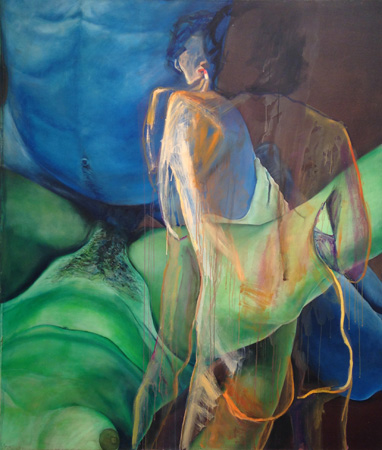 Twins,” 1973/1992
Twins,” 1973/1992
Perfil infinito, 1966, oil on linen, 76.38h x 67.32w in
Centered from “With Camera” series, 2002, oil on canvas, 48h x 53 w in
Beachbody from the “Beach” series, 1985, oil on canvas, 68h x 68w in
Purple Diagonal from the “Echoing Images,” 1980, oil on canvas, 78h x 104w in
Overlays Series, “Twins,” 1973/1992, oil on canvas, 68h x 58w in
All images taken by Arteidolia
FOOTNOTE: In another review of this same exhibition, Daniel Gauss quotes Joan Semmel in Art Fuse:
“I had returned from Spain looking for the ‘sexual revolution’ and instead found sexual commercialization that mostly showed female bodies for sale. I wanted to find an erotic visual language that would speak to women. I was convinced that the repression of women began in the sexual arena, and this would need to be addressed at the source.”
Hardly a better contemporary confirmation of this necessity to take charge of self representation could be found than just a few blocks south at Jack Shainman Gallery where Hank Willis Thomas’ Unbranded: A Century of White Women, 1915 – 2015, a photosampled work of visual culture archeology documenting U.S. advertising’s representation of Euro-American women.
Precilla Frank quotes Thomas in Huffington Post:
“Whiteness is something I’m fascinated with because it’s ever evolving,” Thomas explained. “One hundred years ago a lot of people we call white today would not be considered white. And also, a hundred years ago women in the U.S. didn’t have the right to vote. And, even though African American men technically did, everything was done to make sure they didn’t. I’m interested in how white women — who are often seen as the most valuable — are at the same time marginalized.”
Thomas’ collection of images is chillingly instructive. Joan Semmel’s commitment to a livable realism reaches way beyond painting style.

Thank you so much for your thoughtful, lovingly written, and wonderful response to my exhibition.
Joan
Thank you for a beautiful affirmation of the continued efficacy of painting…along with an astute look at Semmel’s work. (PS We are old acquaintances from the home schooling world)